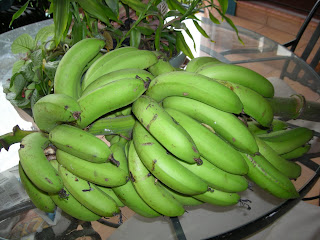Since I'm living in Honduras, the original Banana Republic, I should be growing bananas, right? Not too shabby a harvest − there are at least 50 bananas here!
Oh, they are a little small, I'll admit, but the plants weren't fertilized, weren't sprayed with nasty poisons, and were only watered once during that long dry spell we had, so I'd say they did pretty well.
Banana plants only produce one stalk of bananas and then they die, and are chopped down. Ours always fall down, often before we want them to. The problem is that a stalk of bananas is so heavy, it just pulls the whole plant down with it. We prop them up sometimes, but our bananas mostly grow in spite of us, not because of us.
I can't tell you what kind of banana these are. We bought the plants from someone out of their garden, and as a matter of fact, they were supposed to be platanos (plantains), but that's okay. I hope that we have another one of those mystery popoulu plants. Those were really good.
It's difficult to tell a banana plant from a platano. It can be done, though, Neotropical Savanna tells us. Frank says that he can tell, but we can't until the fruit forms.
As the plants are growing the mother plant sends up little shoots, or pups, so you get new, free plants. According to my tropical gardening book, the custom in Malaysia is to maintain three plants in each clump. One full-size about to produce plant, one half-size, and one new baby. That way you'll get fruit three times a year from the same little space. As you get extra pups, they can be planted in other areas. My book says the same plant can continue in the same spot for about five years, after which you'll need to pull it up and renew the soil.
We like green bananas best and these will stay green for quite awhile. Even so, there is no way we eat that many bananas so we gave about half the stalk to Frank. I see a lot of tajadas in our future.



 Welcome to my Blogicito —
Welcome to my Blogicito — 







